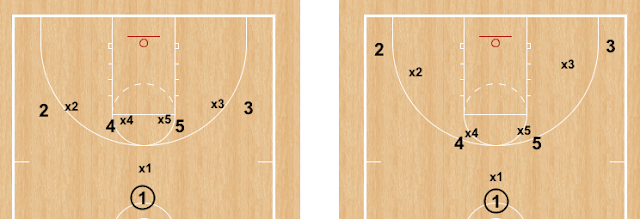Total freshness ain't possible. Does your favorite locker room have a new car smell or the scent of tape balls, sweat, Tuf-Skin, and a little bleach? I thought so. If that means anything to you, then don't pretend ignorance of orange slices, rat tails, and failed freshening of the world with Right Guard. Tactile and olfactory imagery etch our subconscious.
Gorrammit, give me something I can use! Every first grader knows the values of flashcards, as do medical students, and language schools. Andrew Cohen writes, "But there’s a reason that flashcards have been a preferred study method for hundreds of years: They friggin’ work!" How? They build neural connections...they change the brain.
Let's use them to teach.
Spacing and magnetic polarity.
Spacing has "polarity" like magnets. Spacing should "repel" teammates on offense, while the ball "attracts" defenders.
4 can't be serious. NEVER CUT TO AN OCCUPIED POST.
More Alike Than Not. Horns, 1-4 High.
The Packers could announce the "Power Sweep" and still execute it. Players shouldn't care about the "presnap read" because lines on the page don't write the sentence.
I'll be back. The Terminator had no mercy.
"Spread" or "50" or "5-out" or "Open" or "Area 51" or "Siberia." Players recognize the offense opening the middle for drives, give-and-go, back cuts.
Triangle doesn't mean one way.
The initial structure doesn't define the options.
Formation Flexibility.
Iverson cuts aren't the first available option off 1-4 high. But they flow nicely into multiple options. Or you can diagonal screen for your bigs. #StaggeredScreens
Iverson squared.
Morph. Great Offense = Multiple Actions.
Carla Berube's Tufts transformation of spread offense into backdoor action.
Coach Auriemma's UCONN 'Horns' set runs through backdoor action, into a staggered screen for a perimeter shot, or into an elbow pick-and-roll.
Ball Screen Deception
1-4 low transforms into a high pick-and-roll with a cross-screen chaser. Drink up.
Horns into screen-the-roller (Spain PnR) action
If players can learn ecoutez et repetez they can learn flashcard offense. Build series of flashcards for sets, motion, BOBs and SLOBs, ATOs, Zone offense, and Game Winners. Only imagination limits the possibilities.
Lagniappe:
Excerpt from Thinking Volleyball by Mike Hebert. Coach Hebert took his talented University of Minnesota volleyball women (30-4, 11th ranked in US) to Japan to train and compete against several Japanese university teams. Despite a huge edge in size and athleticism, the Gophers went 0-42 in sets, but did go 8-3 against HIGH SCHOOL competition.
"Sherry pressed onward. “If your players practice 8 to 10 hours a day, when do they go to class and study?” she asked. “This is not my problem,” he answered without flinching.
This approach to volleyball works for the Japanese. It fits their culture. They are notoriously dedicated to their work. There is little room for failure. There is great attention to detail. Everything we witnessed during our visit confirmed these observations. The long hours in the gym, the elite level of skill acquisition, the tolerance of severe physical punishment following failure, and the unconditional team loyalty expressed by everyone in the program—all of this gave us a rare look into how Japanese culture shapes the way their volleyball program is designed."
"Americans, first and foremost, are independent. They are motivated by individual challenges. Once joining a team, they have to be trained to behave as a team, where group goals are more important than individual goals. This will not come naturally. If and when they do commit to a team goal, it is sometimes done begrudgingly, and they expect to be rewarded for such a concession of individual freedom on their part. Teaching skills to an American team can be very difficult because each of the players will want to do it his way. American players often resist sameness and group discipline. It can be hard for Americans, who are so independent, to trust each other when adversity strikes. The challenge for coaches of Americans is to orchestrate a team concept in an environment that so fiercely protects a self-first mode of thinking."













